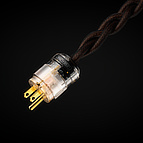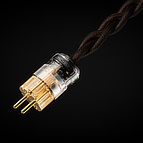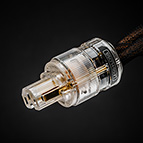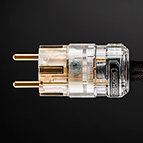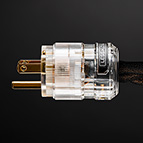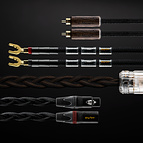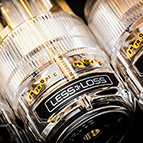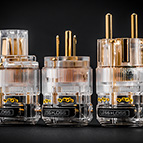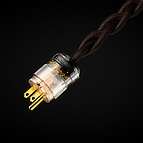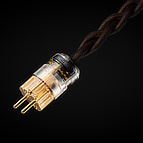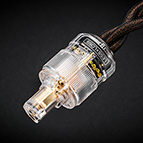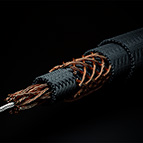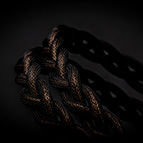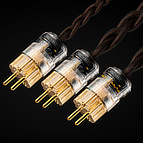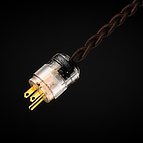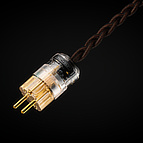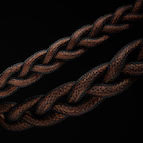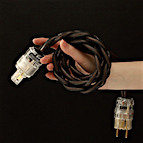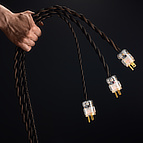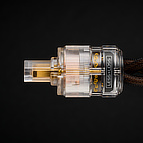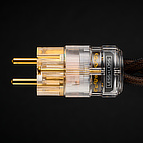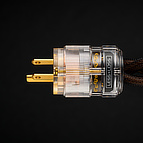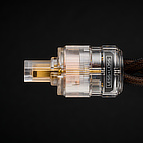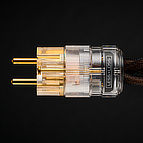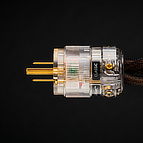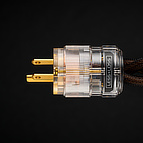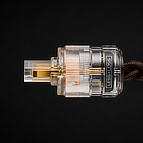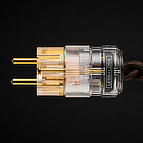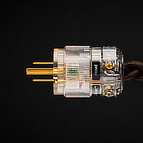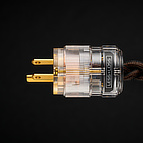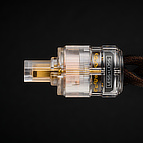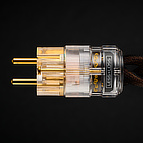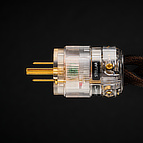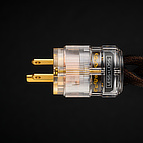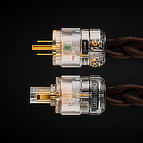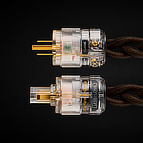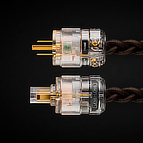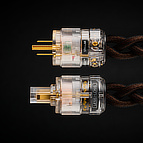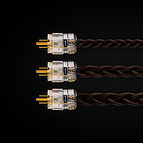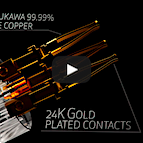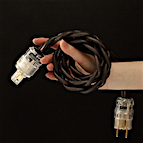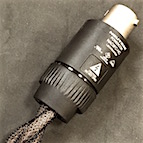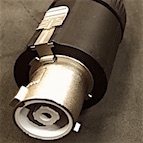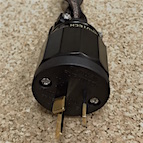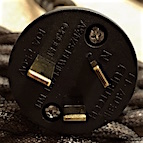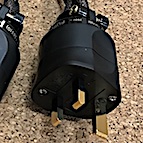 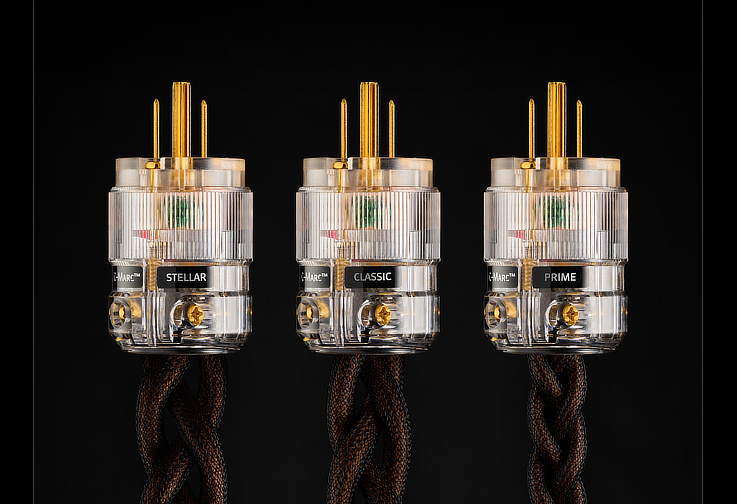 Introducing C-MARC™. A new generation of high-performance wire and cable, well equipped to deal with todays over polluted electromagnetic environment. C-MARC™ is a new type of Litz wire. C-MARC’s noise reduction is based on the bucking coil method using two counter-polarised coils. Every strand's clockwise turn aligns with a corresponding counter clockwise turn of precisely mirrored diameter and step. The two, resulting counter-polarised coils are mutually superposed. A second-scale fractal replication of the already bucking coils is then repeated. Through electrical cancellation of the induced noise, C-MARC™ provides an enormous signal-to-noise ratio in today's demanding audio environment. 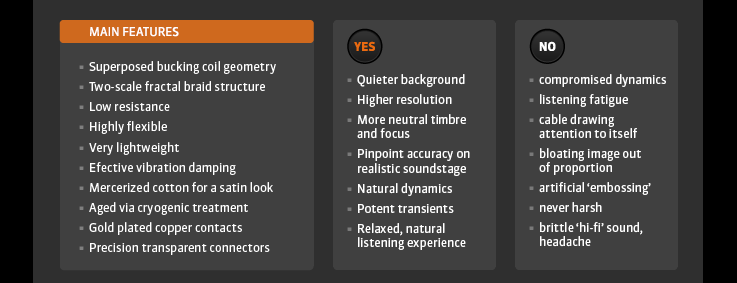 





Entropic Process: A LessLoss technology most profoundPictured below is the new insignia of the ultimate LessLoss achievement. When you see this symbol, you can rest assured that sonics don't get any better than this!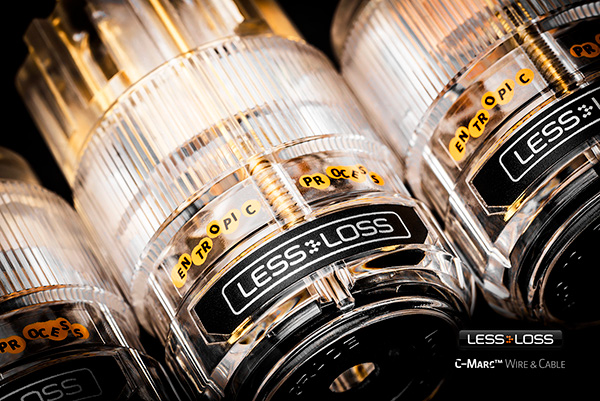
We have been investigating the mysterious burn-in phenomena for the past 20 years, following it very closely and learning ever more about it. Finally, we have figured out a way to actually use it in the design of an actual product. This has been on our creative minds ever since day one when we first experienced burn-in decades ago. But the secret within has remained elusive to us—until now! This does not mean we have abolished all initial changes in sound quality. It only means we have developed the means and methods to accelerate it—pre-prime it, so to speak—to the point where, in your first two weeks of listening, you might go through some 200 years of regular burn-in. The burn-in process has not been disposed of by us but rather put into overdrive in order to serve listeners even better! This is the genius of our new Entropic Process. To fully comprehend the concept behind it, prerequisites are in order.If you have never experienced any strange burn-in effects…you will not yet know that of which we speak. The strange burn-in effect remains, undoubtedly, the most mysterious of all aspects involved in high-end audio. Appreciated, experienced, and accepted by thousands, yet understood by none, it remains an uncracked code of mystery which has represented a strange bottleneck to designers until now. Sometimes it is a cause of ridicule, but sooner or later everyone experiences it…and suddenly that voice of ridicule is noticeably quiet.What is burn-in?Burn-in is a strange phenomenon in which newly made gear or cables go through a series of inexplicable initial transitional phases in terms of performance. One day the sound may be brittle and coarse; another day the sound may be rubbery and elastic. One may experience phases of bass-heavy submersion as if one is under water, then periods where one feels the bass is too weak or not in balance with the mids and treble. Eventually, these two extremes converge into a balanced, stable performance, a mature and pleasant tonal balance.This process is dependent on two things. First, much depends on total system transparency. If the system has deep flaws, such as being located in a room with ceramic tiles and many exposed glass windows, of course an acoustic echo chamber like that will mask such effects greatly. However, if the system is set up well in an acoustically well-organized space, you'll hear the flaws with ease. Secondly, it depends on how sonically neutral the fresh product actually is. If it is severely skewed in some arbitrary tonal direction, it will be more difficult to sense just what is going on in terms of this burn-in process. An example of this is found in multi-strand copper conductors with silver plating. But if a product is a sonic giant in terms of its ability to present exactly what is taking place in the recording, without editorialising, one will hear huge burn-in swings initially. It is most likely that LessLoss products present exactly the same changes that any new wire goes through. The only difference is that C-MARC has such a fantastically low noise floor that one can more readily perceive and experience these large burn-in swings because so much more detail is exposed to the listener than usual. It goes without saying that you simply cannot have it both ways: you cannot expect a totally transparent cable to reveal real data on a recording that won't simultaneously also reveal a much deeper underlying physical aspect of burn-in as it matures and settles in performance. The performance is the ability to show more and more minute changes in signal. This also must mean, at the same time, that it will show more and more minute changes in whatever actually constitutes burn-in (molecular structure re-alignment or something…? sorry, we haven’t solved everything!). And a mystery it is and remains. But we have made a HUGE step in accelerating it.If, before, you experienced the infamous ‘roller-coaster ride’ of settling and opening up, now it will be a supersonic rocket launch with G-forces you had better be prepared for. After the rattling of instruments, mind, muscle and bone, the view, once in orbit, of that rarefied silent cosmos, is really worth the patience. Burn-in time is not necessarily longer or shorter…it is just more intense.Both the C-MARC™ power cable and C-MARC™ Entropic Process power cables are superb performers. It takes us 18 hours to make the C-MARC™ power cable and no less than 30 hours to make the Entropic Process version. 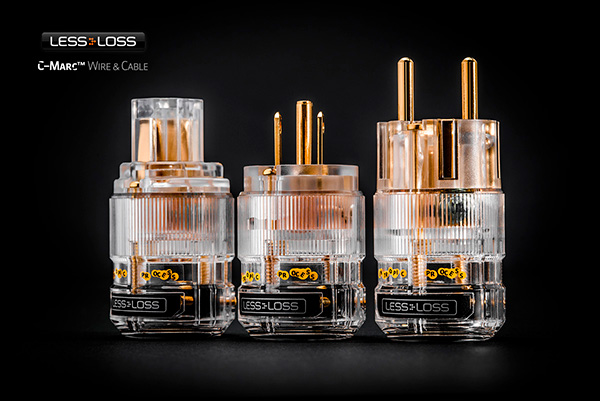
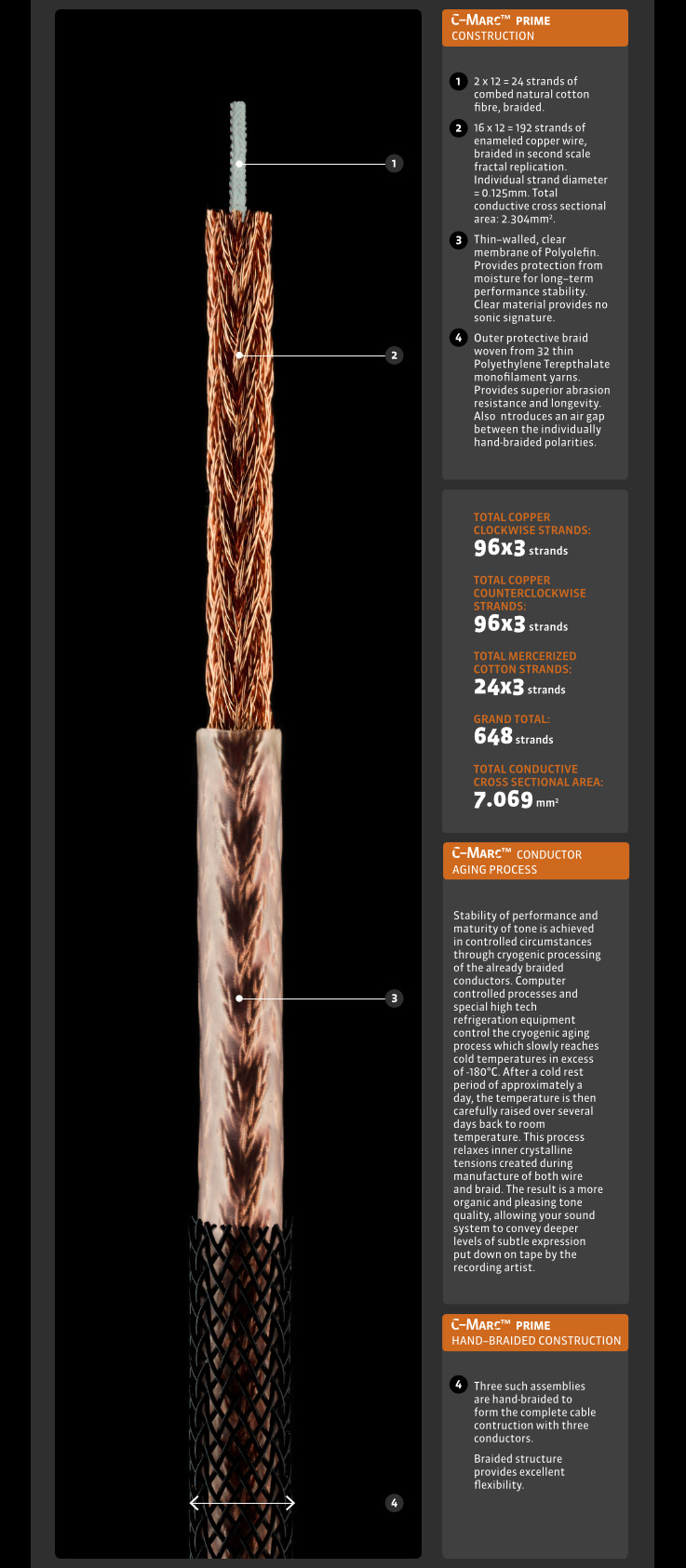   C-MARC™ PrimeWe're happy to announce the new attractively priced C-MARC™ Prime power cable! This is now undoubtedly the best price/performance ratio product on the audio market today!C-MARC™ Prime features all the high performance features of our C-MARC™ Classic power cable, including:
The high performance plugs have great features as well:
What are the differences between C-MARC™ Prime and C-MARC™ Classic?C-MARC™ Prime has a somewhat smaller appearance than the C-MARC™ Classic. The total cross section is the only difference between this power cable and the C-MARC™ Classic. Whereas C-MARC™ Classic has two complete dual fractal braids per line, the C-MARC™ Prime has one. C-MARC™ Prime is priced very attractively and is not available in Entropic Process form. Our trajectoryWe want to become accessible to more and more audiophiles. C-MARC™ Prime is the easiest way to get 'one foot in,' so to speak. After that, LessLoss will always cater in the most friendly way should one want to continue the path towards audio perfection that LessLoss has over the course of several decades paved.LessLoss very friendly upgrade policies - your investment counts!In the future, we will honour very attractive upgrade offers from Prime to Classic and to Classic Entropic Process, for any owner. In fact, we will structure the upgrade policy such that it will make no sense to put them onto the used market. Basically, purchasing Prime will be very near equal to initial investment into Classic, but with the instant receipt of the beauty of tone you're wishing for, today!Example: Purchase Prime: 486 USD. Shipping included. Enjoy Prime for a year. Decide to trade Prime in for Classic: 1148 - 413 = 735 USD. Or: Purchase Classic: 1148 USD. Shipping included. Enjoy Classic for a year. Decide to trade Classic in for Classic Entropic Process: 1934 - 746 = 1188 USD. Or: Purchase Classic Entropic Process: 1934 USD. Shipping included. Enjoy Classic Entropic Process for a year. Decide to trade Classic Entropic Process in for C-MARC™ Stellar: 2450 - 1257 = 1193 USD. LessLoss covers both shipping legs and also includes free fresh packaging for the return of cable to be upgraded. There is no system down time. You first receive the new item, then you return the other. You don't even have to leave home! UPS picks it up free of charge to you! Branding labels from now onTo avoid any confusion, from now on, all C-MARC™ power cables come with labels clearly denoting the model type attached to the plugs. These are applied to the inner walls of the transparent plugs, so they will never rub off, even with rough use, for example in the context of a live traveling stage band setting.C-MARC™ stands for Common-Mode Auto-Rejecting Cable.C-MARC™ is unlike any other hook-up wire or cable currently produced. It is based on the bucking coil method of noise reduction, used most famously in twin coil pickup designs first developed in the mid-1930s to silence hum from electric guitars.This type of guitar pickup was called ‘the humbucker’ because it 'bucks the hum', i.e., noise, out of the desired guitar signal through phase cancellation of two counter-polarised inductors. When the inductors both induce a common signal, it is induced in opposite polarities by each coil. These opposite polarities then mutually cancel when the two counter-polarised noise currents are combined through simple electrical summation. Humbucking coils are also used in some microphone designs, as well as in sensitive sensor technology where induced stray noise is not acceptable and the highest signal-to-noise ratio is desired. LessLoss designs a new type of wire around the humbucking principle.C-MARC™ wire is a special type of Litz wire. It features all of the known benefits of traditional Litz wire, but without the disadvantage of being formed as an elongated coil (inductor).Traditional Litz wire has the following advantages over normal 'naked' multi-stranded wire and solid core wire:
(1) Traditional Litz wire is bunched and then twisted in only one direction, leading to the formation an elongated group of uni-directional coils (inductors) of differing diameters, its structure resembling elongated overstretched springs of different sizes. [Fig. 1.: Sketch of typical Litz structure where multiple coil diameters and single coil turn direction resemble several overstretched springs bunched together. This structure allows high speed of production.] [Fig. 2.: Each long separately insulated Litz wire can be seen as a separate coil of a given diameter and step. The different diameters are a result of the bunching before mutual twisting.] [Fig. 3.: Individual wires of differing thicknesses are bunched together to form different geometries. Many variations of the Litz structure exist, most of which are based on the main idea of first bunching and then twisting into spirals.] [Fig. 4.: Some manufacturers offer braided Litz wire, so-called “Type 7” Litz. This wire also is formed from initially bunched and mutually twisted strands before braiding. This type of wire is compressed after braiding the twisted bunches into an overall rectangular shape before tape wrapping and over-extrusion.] How C-MARC™ is profoundly differentIn contrast, C-MARC™ wire goes down to the very fundamentals in a completely mirrored, balanced geometry. It aligns every Litz strand's clockwise turn with a corresponding counter clockwise turn of exactly mirrored diameter and step along the length of the wire. These two resulting spirals are mutually superposed in counter-braided fashion. Noise is thus induced in exactly opposite polarities and in exactly mirrored amplitudes, while the good signal is common to both spirals. The two counter-polarised noise signals mutually cancel when the two counter-polarised currents are combined through simple electrical contact at both ends of the wire. Thus, through auto-rejection of opposing electrical phase through summation at the ends, C-MARC™ wire perfectly counters the noise induction, whether from external sources or self-induced, which normally pollutes every other twisted Litz wire assembly. In this way, C-MARC™ wire achieves signal transfer which is corrupted substantially less than the industry has been able to achieve through other means.[Fig. 5.: C-MARC™ Litz schematic layout. The clockwise and counter clockwise spirals are mirrored in diameter, step and wire gauge, while at the same time superposed in relation to one another. This results in opposite phase induction within the very structure of a single polarity line. While production speed is substantially slower, the silence of operation of C-MARC™ wire is far superior to standard Litz structures.] (2) This is not all! LessLoss C-MARC™ wire features two-scale ‘fractal’ replication of the aforementioned mutually superposed counter-twisted layout. This mirrored and nested structure further enhances the mutual cancellation of counter-polarised inductive twists, while at the same time allowing enlarged overall cable cross-sectional designs which serve to further lower resistance without any sacrifice of signal fidelity or flexibility. 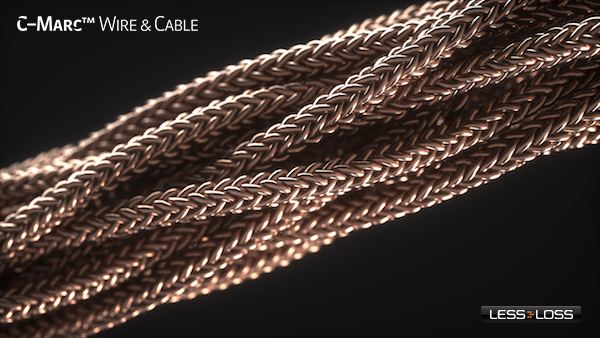
[Fig. 6.: C-MARC™ shown in two-scale fractal replication. Everything that occurs geometrically at the core level is repeated again at the larger level, thus further reducing the induction of noise. Just as the initial clockwise and counter clockwise spirals are mirrored in diameter, step, and wire gauge, while at the same time superposed in relation to one another, so too at the larger level. This makes the cable a silent performer without influencing the natural tone colour of sensitive signals throughout the frequency spectrum.] What this meansC-MARC™ is intrinsically the most silent wire on the planet and provides pure transmission of signal. The degree of silence of the working solution is in direct proportion to the degree of superposition of the counter-polarised twists, as well as in the degree of their mirrored equality in terms of turn radius, step, and resistance. The idea being that in the best of worlds, both opposite ‘polarities’ of a single lead of C-MARC™ wire induce the exact same noise, and a perfect summation to zero will result at both ends of the line.(3) Because the individual enamelled wires which make up the unique Litz structure of the C-MARC™ wire are so small in diameter (0.125mm), the ratio between total surface area and total cross section is further enlarged for an even better phase relationship across the entire spectrum. (4) This structure further enhances flexibility and ease of bed on any axis, especially for large cross-sectional cables, without unnecessarily enlarging the entire cable assembly. (5) The strands used in C-MARC™ wire are covered with the thinnest technically possible colourless enamel. They are solderable once tinned in a soldering pot. (6) The plastic protection is thin. This results in a very lightweight, highly flexible, natural-sounding product with today's best performance characteristics for delicate audio applications with an enormous signal-to-noise ratio. What can I expect in terms of sound?Well, you won't hear coloration, that's for sure. You will however hear a lot more of the music's expression and true content. Click here for a bunch of reviews which will show you how various people in the press and users have expressed what they have discovered using C-MARC™!How does the new C-MARC™ Cable compare to the DFPC Reference?The tonal character of C-MARC™ is more liquid and fluid, and it resolves more detail from any recording. As good as the DFPC Reference is, it is still covered with rather thick plastic (albeit very high-quality plastic with excellent characteristics). The C-MARC™ power cord's features a thin layer of clear plastic which is more flexible, and the extremely well-balanced counter-polarised coil technique lowers the noise floor even further than the very effective Skin-filtering employed in the DFPC Reference. The overall result is one of both lowered noise and greater tonal character. It is very easy to recognise these improvements straight from the start, even without burn-in.Another improvement is found in the connectors. In C-MARC™ they are not made of brass but rather pure copper. And, instead of glass filler in the black plastic of the housing, entirely clear and extremely stable plastic is used. If that weren't enough, these connectors are cryogenically treated, whereas the 079s are not. All of these improvements add up to obviously superior results from the outset. After about fourteen days of settling, the sound quality becomes even more organic and lifelike. We are confident that C-MARC™ is here to stay and that, after a few more years, it will be recognised and employed in many different manufacturers' loudspeakers and equipment as internal hook-up wire. One further advantage of C-MARC™ over the DFPC Reference is its extreme flexibility and light weight. Thus, even the most sensitively placed lightweight gear has the very best conditions to maintain the fine vibration control of even the most delicately positioned special tuning feet. See the following image for an idea of C-MARC™ cable's flexibility. Special custom plugs are available.If you need a custom plug on your C-MARC™ power cord, simply inquire. We can make them with high-performance UK-type plugs from Furutech, AU/NZ type plugs from Furutech and 32A PowerCon type plugs from Neutrik. 20A C19 plugs can also be implemented. |
- Products
- Power Cables
-
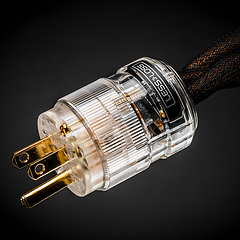 C-MARC™ Prime
The must have foundation for any sound system today.
From
$
486
C-MARC™ Prime
The must have foundation for any sound system today.
From
$
486
-
 C-MARC™ Classic
The unique super-cable power cord everyone's talking about.
From
$
1148
C-MARC™ Classic
The unique super-cable power cord everyone's talking about.
From
$
1148
-
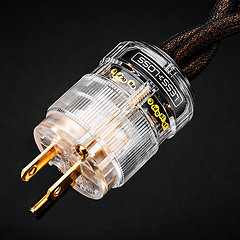 C-MARC™ Classic Entropic Process
The peerless, advanced Classic masterpiece.
From
$
1934
C-MARC™ Classic Entropic Process
The peerless, advanced Classic masterpiece.
From
$
1934
-
 C-MARC™ Stellar Entropic Process
The crown jewel for highest performance power connection.
From
$
2450
C-MARC™ Stellar Entropic Process
The crown jewel for highest performance power connection.
From
$
2450
-
- Loudspeaker Cables
- Interconnect Cables
-
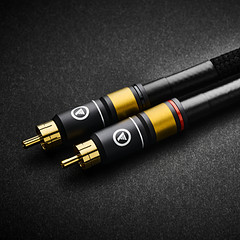 RCA C-MARC™
Cotton-clad true Litz • Whopping 2.3mm2 polarities
From
$
850
RCA C-MARC™
Cotton-clad true Litz • Whopping 2.3mm2 polarities
From
$
850
-
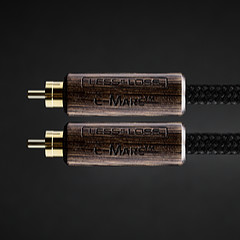 RCA C-MARC™ Entropic Process
Our finest RCA cable • Polished Wenge barrels
From
$
1428
RCA C-MARC™ Entropic Process
Our finest RCA cable • Polished Wenge barrels
From
$
1428
-
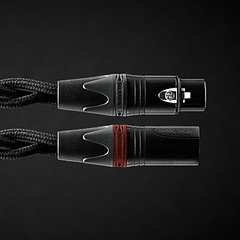 XLR C-MARC™
A hand-braided cotton-clad unique Litz construction
From
$
950
XLR C-MARC™
A hand-braided cotton-clad unique Litz construction
From
$
950
-
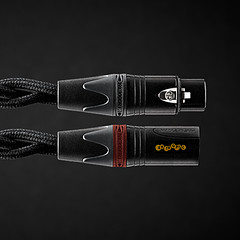 XLR C-MARC™ Entropic Process
Stratospheric performance for the audio connoisseur
From
$
1615
XLR C-MARC™ Entropic Process
Stratospheric performance for the audio connoisseur
From
$
1615
-
- Digital Cables
-
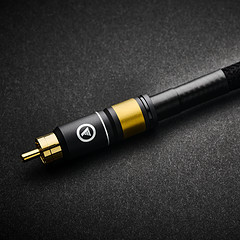 RCA Digital C-MARC™
Cotton-clad unique Litz design • Made only by LessLoss
From
$
510
RCA Digital C-MARC™
Cotton-clad unique Litz design • Made only by LessLoss
From
$
510
-
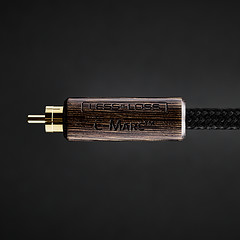 RCA Digital C-MARC™ Entropic Process
Possibly the most subtle digital cable on the planet
From
$
858
RCA Digital C-MARC™ Entropic Process
Possibly the most subtle digital cable on the planet
From
$
858
-
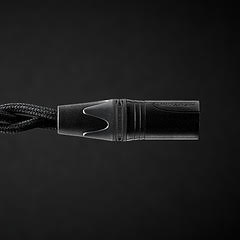 XLR Digital C-MARC™
Featuring a whopping 3 x 2.3mm2 Litz construction
From
$
570
XLR Digital C-MARC™
Featuring a whopping 3 x 2.3mm2 Litz construction
From
$
570
-
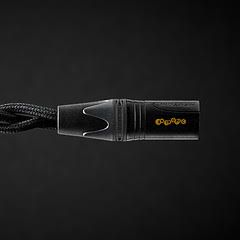 XLR Digital C-MARC™ Entropic Process
Stratospheric performance for the audio connoisseur
From
$
969
XLR Digital C-MARC™ Entropic Process
Stratospheric performance for the audio connoisseur
From
$
969
-
- Grounding Cables
- Bulk Wire and Cable
- Signal Conditioners
-
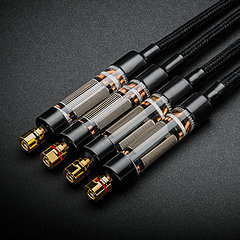 Firewall for Loudspeakers
Firewall for Loudspeakers
C-MARC™ Plug-and-Play Speaker signal conditioning like you've never imagined From $ 1656 -
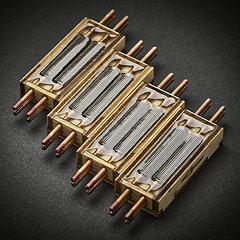 Firewall for Loudspeakers
Firewall for Loudspeakers
DIY version for Self-Installation For the Do-It-Yourself project enthusiast • Solder yourself From $ 800 -
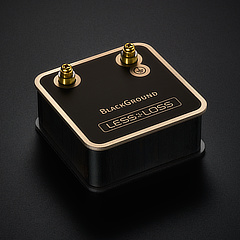 BlackGround DIY
Voltage-ground interface for a variety of applications
From
$
446
BlackGround DIY
Voltage-ground interface for a variety of applications
From
$
446
-
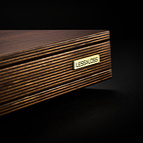 BlackGround 8x/10x Speaker Base
Plug-and-play loudspeaker signal conditioner
From
$
3096
BlackGround 8x/10x Speaker Base
Plug-and-play loudspeaker signal conditioner
From
$
3096
-
- Power Conditioners
-
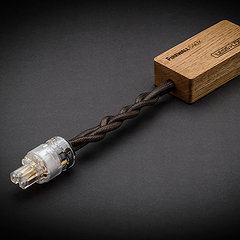 Firewall 640x
Plug-and-play solution for any powered gear
Firewall 640x
Plug-and-play solution for any powered gear
C-MARC™ Entropic Process and standard lead versions From $ 654 -
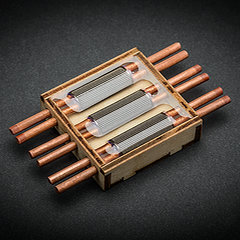 Firewall 640x DIY for Self-Installation
Self-solder and save!
From
$
320
Firewall 640x DIY for Self-Installation
Self-solder and save!
From
$
320
-
 BlackGround DIY
Voltage-ground interface for a variety of applications
From
$
446
BlackGround DIY
Voltage-ground interface for a variety of applications
From
$
446
-
 BlackGround 6x/10x Power Base
Plug-and-play power conditioner
From
$
2350
BlackGround 6x/10x Power Base
Plug-and-play power conditioner
From
$
2350
-
- Power Distributors
- Equipment Feet
- Field Conditioner
- DACs
- Power Cables
- Reviews
- This is definitely the cable to go for. It will almost literally blow your mind. – March 2012, Puresound Magazine
-
I was intrigued by the unanimously positive reviews garnered by these products ...
– by user Raymond Eye
Leaves you speechless
Sensational cables
BEST purchase I've made
Top notch performance
It's a steal
Musical... liquid... 3D
It's not subtle
More than an upgrade
Best I've heard so far
Stellar service
Sounds like a new system
Much more lifelike
Emotional flow
Overwhelming results
More dimensional
Sound is transformative
We were all astounded
Transformed my listening
Sounds so cohesive
Emotionally engaging
- Where to Start
- Free Newsletter
- Newsletter Archive
- B-Stock Alerts
- Shopping Tools
-
Shipping
- Free Shipping Learn about our international shipping policy
-
Return Options
Our satisfaction guarantee
and return policy -
Customs / Tax
UPS expedites local
customs clearance
-
Transaction
- Conditions of Sale Agreement for a smooth business transaction
- Privacy Policy We pledge to keep your information private
-
Terms of Use
Business policies
and agreements
-
Account
-
- Contact Us
-
Meet the Designers
-
- Care to share of your personal experience with our products? We'd be happy to post it!
- Want to learn more about our activities? Our Newsletter is both free and spam-free.
hi-res photos, brochures
logos, press releases, and
print-friendly PDF downloads. -
Contact Us
Connect with Us
-
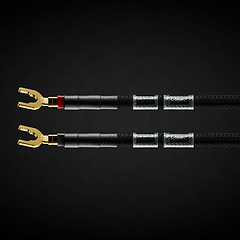
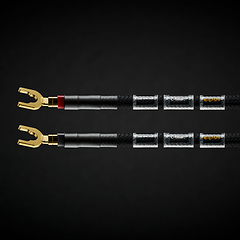
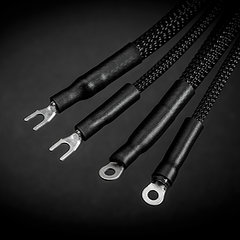
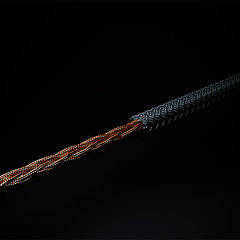
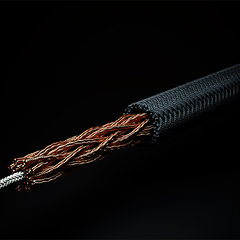
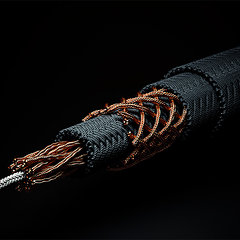
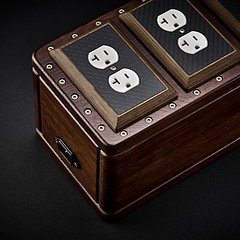
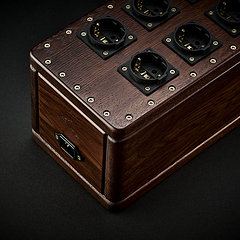

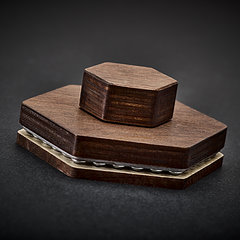
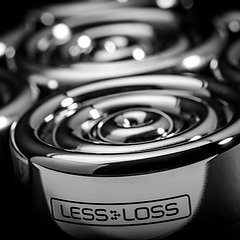
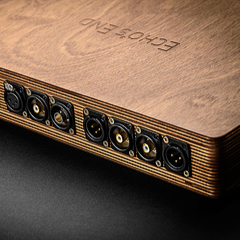
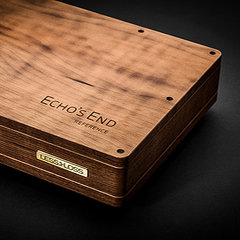
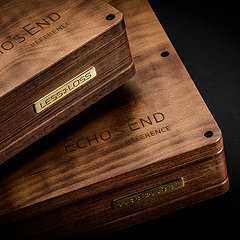
 Beware of Fakes
Beware of Fakes

